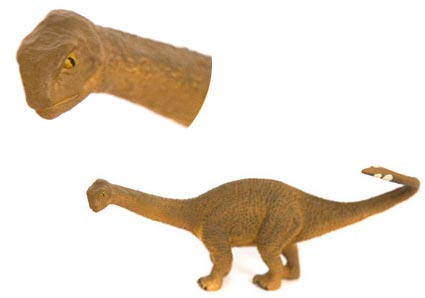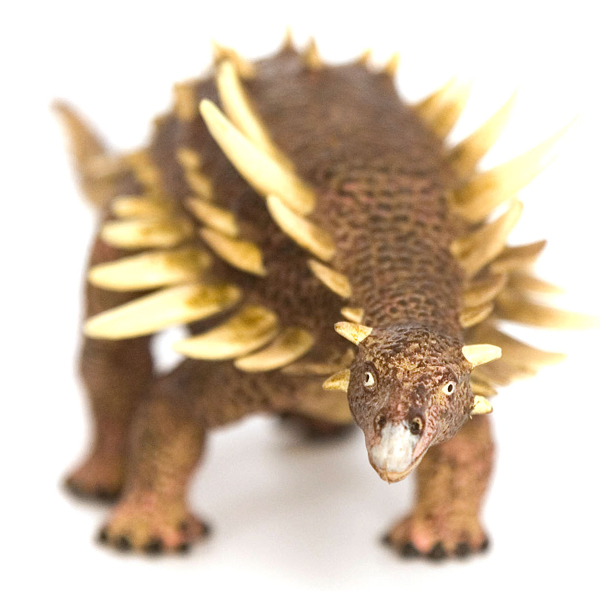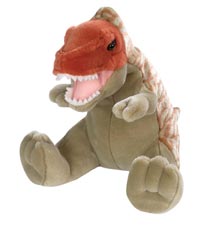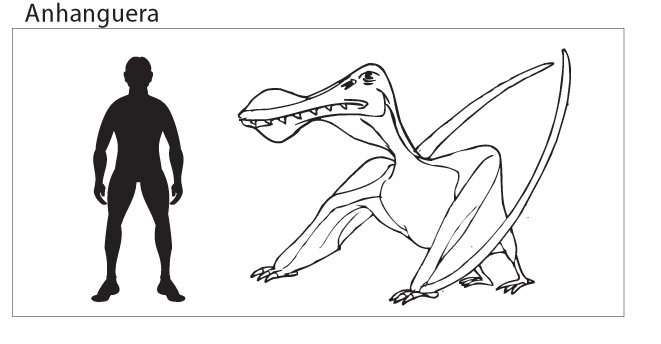Parental Care – Fathers helping to Brood the Eggs
Parental care is a behaviour strongly associated with warm-blooded animals such as mammals and birds, however was parental care a dinosaur trait too? From a human perspective, we can perceive a strong emotional tie between a mother and her offspring when we view the behaviour of a female chimp with her baby, we often superimpose human emotions onto our primate relatives. Whether all the higher apes are capable of exhibiting such a range of emotions is open to debate. Scientists and anthropologists frequently disagree over the breadth and depth of emotions that apes are able to exhibit, after all, our humanity and ability to express emotions and respond to others and their emotions is one of the defining characteristics of being human.
Parental Care
We perceive most mammals as having a strong bond between themselves and their young. From a scientific perspective, mammals invest a great deal in the next generation, the females carry the embryos inside them (monotremes excepted), as opposed to the egg-laying birds and reptiles; the other members of the group of animals called amniotes. An amniote is an animal whose young is internally fertilised. In reptiles and birds the embryo is surrounded by fluid and is protected by a protective shell – an egg. In virtually, all mammals, the developing embryo is also surrounded by fluid but is retained inside the mother’s body for some time before birth.
Maternal and paternal behaviours are easy to impose on fur covered mammals but with the cold-blooded reptiles it is perhaps more difficult to associate these alien looking, scaly creatures with parental responsibility. We now know that a number of species of reptile demonstrate some form of parental care, in extant reptiles, this is perhaps developed to the highest degree by the crocodilians, those reptiles alive today that are most closely related to dinosaurs.
Dinosaur Trait
For many years, white European explorers did not believe the stories told to them by the native American Indians about Alligators looking after their young. Scientists now know that Alligators, along with other types of crocodilian show a strong bond between their offspring and even the nest in which the eggs were laid. Female Alligators guard the nesting sites, protecting the eggs as they incubate. When alerted by the chirping and pipping sounds made by the young as they are about to hatch, the females will dig the nest out and escort the brood down to a nursery area, carrying many of the newly hatched baby Alligators in her jaws. When first observed by Europeans, this behaviour was thought to be cannibalism, reinforcing the beliefs about the cold-blooded and uncaring reptiles. Many text books written as late as the 1970s documented this behaviour and cited it as evidence of the harsh and cruel nature of crocodiles.
When the role of mammal parents is considered, the burden of responsibility for the brood and the rearing of young lies very much with the female. In many species of mammals, the male has nothing further to do with the parenting process after mating. Male tigers, for example, leave the impregnated female to fend for herself, give birth and to raise the cubs. These cubs may stay with their mother for as long as two years. The male plays no real role in raising the family – although they may offer protection indirectly by maintaining a territory and keeping rival males at bay.
With modern species of birds, in contrast, the male usually plays a role in brooding the clutch of eggs and helping to feed the hatch-lings. Indeed, with some species of birds such as the Ostrich, it is the male who carries out the greater portion of the parental duties. A new research paper, published in the professional journal “Science” suggests that birds may have inherited their brooding behaviours from theropod dinosaurs.
A Place for the Father – A Fossil Theropod Nest
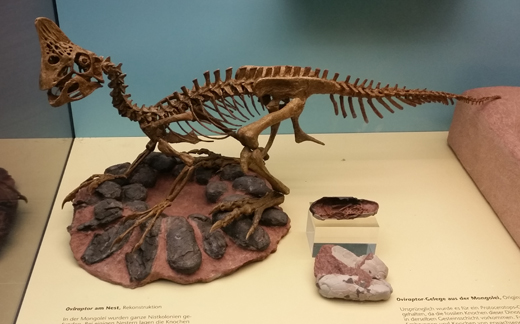
An Oviraptor dinosaur sitting on her nest. Picture taken by Everything Dinosaur team members (Frankfurt). Picture credit: Everything Dinosaur.
Picture credit: Everything Dinosaur
The picture above is of a fossil nest of a dinosaur. By studying the unborn, baby dinosaurs preserved inside the eggs, scientists have been able to determine that this was the nest of a oviraptorid dinosaur – a member of the theropod group.
Studying Birds
In more than 90% of modern bird species (neornithes), it is the male parent that volunteers to sit on and incubate eggs in the nest. By comparison, males contribute to parental care in fewer than 5% of mammals and even more rarely among crocodiles, lizards and snakes. With the majority of the mammals and reptiles it is the girls that do all the work when it comes to raising the youngsters.
However, the remains of several types of Cretaceous theropods, bird-like dinosaurs have been found in association with fossil nests. Scientists believe that these dinosaurs were brooding the clutch of eggs, adopting what we would recognise as bird-like incubating and protecting behaviours. The research paper, puts forward evidence to suggest that the animals brooding the nest were actually the males – but how can a scientist be certain of the sex of an animal when they only have the fossilised skeletal remains to go on?
Eggshell Formation
It is thought that theropod dinosaurs laid their clutches of eggs all in one sitting, laying eggs using both their oviducts, hence the eggs are laid in pairs and this can be seen in the picture of the fossilised theropod nest above. In contrast, birds only have one oviduct this is believed to be an adaptation for flight, the birds evolving a lighter skeleton and losing an oviduct to save weight. To produce the eggshells the female needs a source of calcium and phosphorous to help her make the protective shell for her embryos. These minerals are sourced from her own bones. Specialised reproductive bone tissue is laid down inside the bones of the female during ovulation. This extra bone tissue is converted into the resources required to produce the eggshells. The bone used in this process is called medullary bone. Once the temporary tissue has provided the necessary calcium and other minerals for eggshell formation; it is completely reabsorbed into the body but tell-tale bone cavities are left behind for a time after the egg-laying and if identified within a fossil bone, this is strongly indicative of the fossil bones belonging to a female dinosaur.
Medullary bone is only found in modern female birds, no other egg-laying animals, including crocodiles produce this special bone tissue naturally.
The researchers led by Dr David Varricchio of Montana State University examined the fossilised bones of three species of theropod dinosaur – Troodon formosus, Oviraptor philoceratops and Citipati osmolskae, (another oviraptorid dinosaur from Mongolia). The fossils had all been found in association with nests and many of the specimens had been preserved in a brooding like posture. The researchers examined the internal structure of the fossilised bones, looking for bone cavities that would have been left after the process of egg formation. The lack of any evidence for bone cavities, led the scientists to conclude that these fossils represented males. The assumption being that these were the fathers and that they were brooding the nests, a behaviour seen in most types of modern bird.
Generalising for a moment, in birds, large clutches of eggs are associated with paternal care (the male doing most of the brooding work). Small clutch volumes are associated with care by both parents and medium clutch volumes with maternal care, the female doing the majority of the sitting on the nest.
Commenting on the conclusions drawn from this study Dr Varricchio stated:
“Paternal care in both troodontids and oviraptorids indicates that this care system evolved before the emergence of birds and represents birds’ ancestral condition”.
So perhaps, next Spring, when you see a male garden bird dusting his feathers or taking a dip in a puddle to refresh himself as he takes a break from his incubating duties you could dwell on that behavioural trait being a direct link between the birds you see in the garden and their dinosaur ancestors.
Deducing Behaviour from the Fossil Record
Deducing behaviour patterns from the fossil record is an extremely difficult process. Many theories can be put forward, but the trouble is, it is very difficult without the living species to prove a behaviour conclusively. The role of males and females in rearing dinosaurs will debated for many years to come, perhaps more fossils of dinosaur nests will be found and more evidence gathered. One of the problems with relying on bone cavities to assess the sex of a fossil is that it is often difficult to analyse the internal structure of the bone in its permineralised (fossilised state). Another problem is that their is no real chronological record left in the fossil record when it comes to studying dinosaur nests. It is unclear how long the incubation period would be. With birds for example, the gestation period can be 3 weeks with a reptile, such as an Alligator it can take up to 75 days for eggs to hatch. With limited information available on the gestation period for dinosaurs, it is possible that the bone tissue could have returned to normal and bone cavities would not be present after a period of brooding on the nest. If this is the case then the fossil specimens found in association with dinosaur nests could be female, the cavities could simply be no longer present by the time the animal died.
Visit Everything Dinosaur’s award-winning website: Everything Dinosaur.



